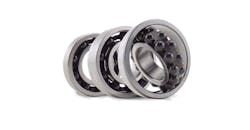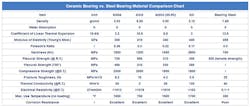Ceramic Hybrids Offer Higher Speeds, Lower Friction and Longer Life
Ceramic Hybrid Bearings have steel races and ceramic balls, which are of greatest value when high loads, high speeds and extreme temperatures are factors. Long life and the need for minimal lubrication make this material appropriate for extreme applications. Ceramic is non-porous, non-magnetic, non-corrosive and lighter than steel. In ball form, ceramic balls are also harder than steel and because ceramic balls are non-porous they are virtually frictionless and capable of spinning faster than steel balls.
Ceramic Balls are usually made of following materials:
- Silicon Nitride (SiN4)
- Alumina Oxide (Al2O3)
- Zirconia Oxide (ZrO2)
- Silicon Carbide (SiC)
Because ceramic is a glass-like surface, it has an extremely low coefficient of friction and thus is ideal for applications seeking to reduce friction. Ceramic balls require less lubrication and have a greater hardness than steel balls which will contribute to increased bearing life. Thermal properties are better than steel balls resulting in less heat generation at high speeds.
Ceramic Hybrid Bearing Benefits
- Combat factors like high loads, high speeds and extreme temperatures
- Increase bearing life and decrease down time
- Minimal need for lubrication
- No cold welding between ceramic balls and races
- Multi-purpose use in variety of machines and different production lines
- High efficiency, low weight and small size
Ceramic Hybrid Bearing Applications
Ceramic hybrid bearings are widely used in electric motors, aerospace applications, performance racing vehicles, laboratory equipment, underwater applications and more. Any application that requires higher speeds, lower friction and longer life are ideal for ceramic hybrid bearings.
Want to save a million barrels petroleum a year, simply by changing the bearings in your machines? It sounds too good to be true, but new materials now make more efficient ball bearings possible. A microscopic look at the surface finish of a metal bearing ball and race, shows peaks and valleys on both surfaces. Lubricant fills in these valleys with incompressible fluids like oil and grease. This prevents metal-to-metal contact between ball and race.
But if the peaks do touch, the contact area is so small that even a small force on the ball or race results in pressures exceeding 1,000,000 psi. This causes cold welding between the ball and the race. Although system inertia easily breaks the weld, the formation and rupture of the weld generates heat. If this condition continually repeats, the fluids lubricant heat up and fails, eventually leading to the bearing failure itself.
Bearings that use ceramics like silicon nitride (Si3N4), alumina (Al2O3), or zirconia (ZrO2) overcome this problem by eliminating cold welding; ceramic balls can’t weld to ceramic races. Ceramic materials also resist acids, alkalis and salt. For both these reasons, bearings using ceramic balls don’t need oil or grease. Ceramics have lower densities, coefficients of friction, and coefficients of thermal expansion than steel. Consequently, ceramic ball bearings last longer, use less energy, and operate within a greater range of temperatures and environments than metallic bearings do.
Bearings Breakdown: Steel vs. Plastics
With a low coefficient of friction, plastic bearings can be highly wear-resistant and thus often outlast steel bearings. Because plastics typically do not need lubrication—unless utilized in conjunction with steel balls—they are designed to maintain that low coefficient of friction through the life of the bearing. Consider that steel bearings can become pitted, which increases the coefficient of friction and thus often serves as a more expensive alternative to plastics. Indeed, employing plastic bearings instead of steel bearings can reduce costs up to 25%.
In addition, plastic bearings can be used in “wash-down application” environments—often utilizing saltwater and harsh chemicals—without compromising performance. If fact, water even can be considered as a lubricant for plastic bearings. On the flipside, plastic bearings are not able to withstand heavy loads, extreme temperatures or excessive RPMs, as can steel and ceramic hybrid bearings.
So for the most demanding applications, one is best to turn to ceramic hybrid bearings; in short, ceramic hybrids can cost twice as much as full-steel bearings, but the cost per hour of use is comparable and usually superior, while their service life extends at least twice as long as full-steel (and often much longer). Also consider that bearing replacements are required much less frequently on ceramic hybrid bearings, thus providing savings via both maintenance man-hours and in avoiding machine tool “downtime.
Adding It Up: Energy Savings of 1.6 million Oil Barrels Annually
At 3,000 rpm on the bench-top flywheel setup, the all ceramic bearing used 1.25 W less power than the all-metal and metal-ceramic hybrid bearings. The flywheel drive motor drew 10 to 12% less current when running ceramic bearings than when metal-containing bearings were used. To translate these results into energy savings, consider the number of bearings in the U.S. and how many hours each bearing runs per year. For the purpose of this exercise, assume the average bearing has similar dimensions to the ones tested above with a 0.25-in. OD. We can also assume the average bearing runs 8 hours/day, 7 days/week, and 52 weeks/year, or 2,912 hours/year.
The Federal Trade Commission estimates there are 600 million bearings in use in the U.S. The power savings of 1.25 w is equivalent to 5.39 Btu/hour, giving us the following: 5.39 Btu/hour x 2,912 hour/year x 6 x 108 bearings = 9.42 x 1012 Btu/year.
To put this in further context, barrel of crude oil contains about 5.8 x 106 Btu, so the total energy savings is equivalent to 1.6 million barrels of oil each year. While a single design engineer may not be thinking in terms of saving energy for the entire U.S., he or she immediately appreciate the savings from getting rid of oil or grease. Ceramic bearings also can run at higher speeds because there’s no danger of thinning out or overheating the lubricant.
Here's comprehensive breakdown via a Ceramic Bearing vs. Steel Bearing material comparison chart:

